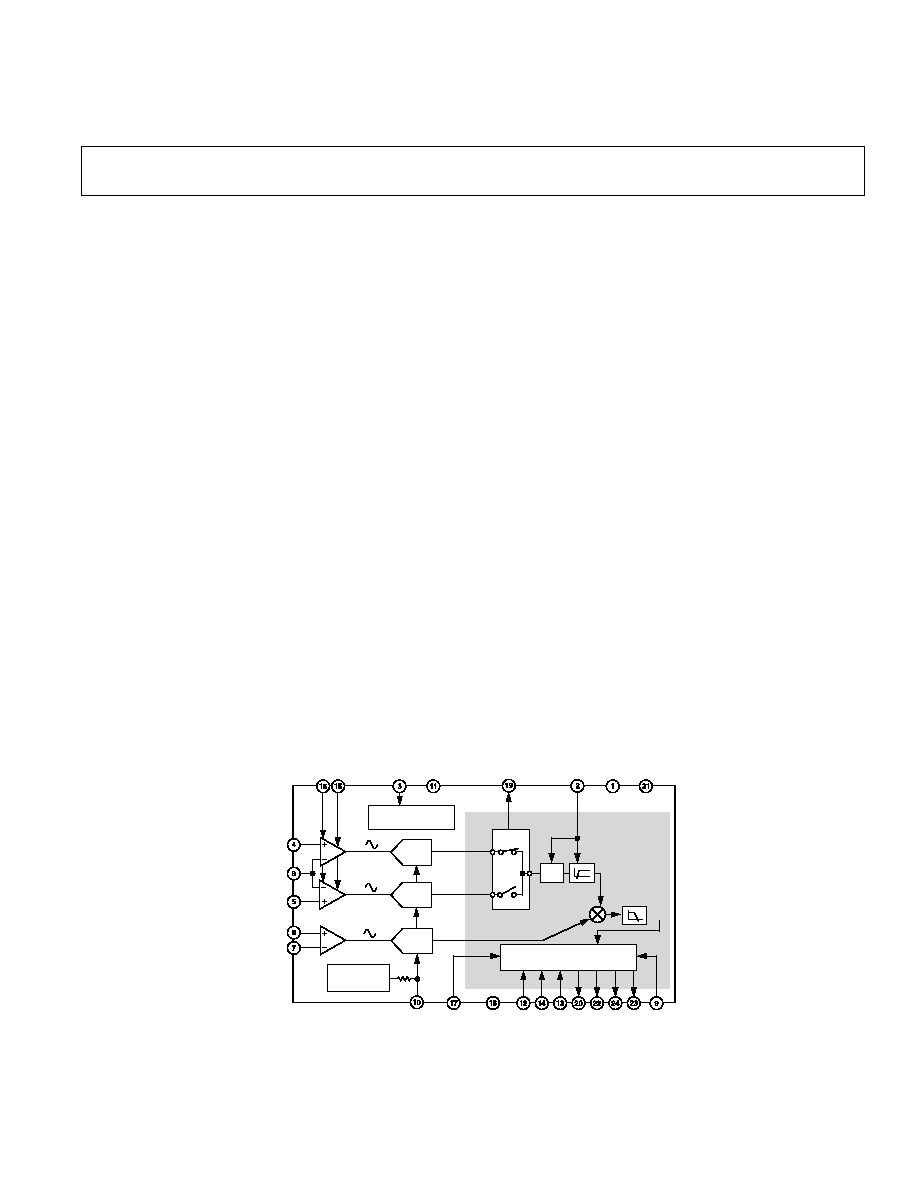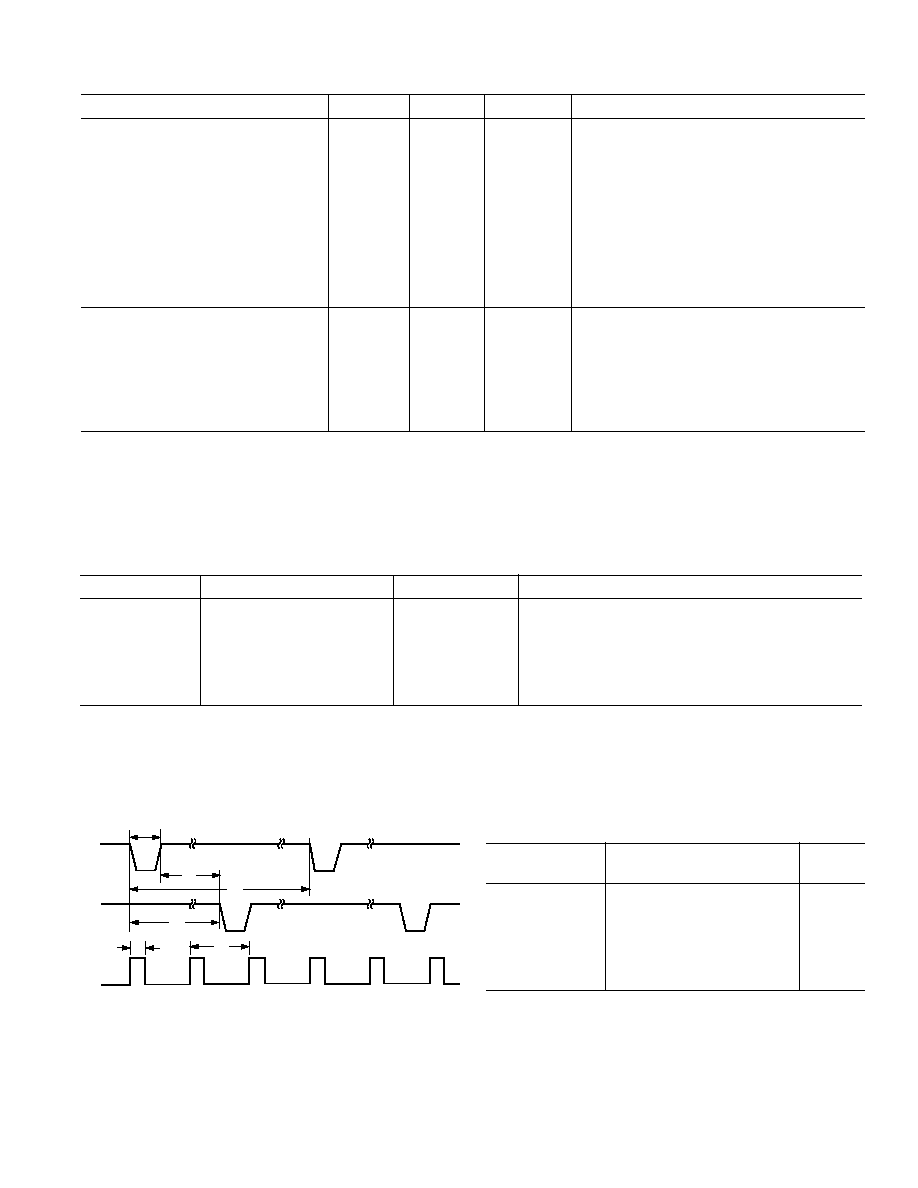Äîêóìåíòàöèÿ è îïèñàíèÿ www.docs.chipfind.ru

REV. A
Information furnished by Analog Devices is believed to be accurate and
reliable. However, no responsibility is assumed by Analog Devices for its
use, nor for any infringements of patents or other rights of third parties
which may result from its use. No license is granted by implication or
otherwise under any patent or patent rights of Analog Devices.
a
AD7751*
One Technology Way, P.O. Box 9106, Norwood, MA 02062-9106, U.S.A.
Tel: 781/329-4700
World Wide Web Site: http://www.analog.com
Fax: 781/326-8703
© Analog Devices, Inc., 2000
Energy Metering IC
With On-Chip Fault Detection
FEATURES
High Accuracy, Supports 50 Hz/60 Hz IEC 687/1036
Less than 0.1% Error Over a Dynamic Range of 500 to 1
Supplies
Average Real Power on the Frequency
Outputs F1 and F2
High-Frequency Output CF Is Intended for Calibration
and Supplies
Instantaneous Real Power
Continuous Monitoring of the Phase and Neutral
Current Allows Fault Detection in Two-Wire
Distribution Systems
AD7751 Uses the Larger of the Two Currents (Phase
or Neutral) to Bill--Even During a Fault Condition
Two Logic Outputs (FAULT and REVP) Can be Used to
Indicate a Potential Miswiring or Fault Condition
Direct Drive for Electromechanical Counters and
Two-Phase Stepper Motors (F1 and F2)
A PGA in the Current Channel Allows the Use of Small
Values of
Shunt and Burden Resistance
Proprietary ADCs and DSP Provide High Accuracy Over
Large Variations in Environmental Conditions and Time
On-Chip Power Supply Monitoring
On-Chip Creep Protection (No Load Threshold)
On-Chip Reference 2.5 V 8% (30 ppm/ C Typical)
with External Overdrive Capability
Single 5 V Supply, Low Power (15 mW Typical)
Low-Cost CMOS Process
GENERAL DESCRIPTION
The AD7751 is a high-accuracy fault-tolerant electrical energy
measurement IC that is intended for use with 2-wire distribution
systems. The part specifications surpass the accuracy require-
ments as quoted in the IEC1036 standard.
FUNCTIONAL BLOCK DIAGRAM
AC/
DC
AV
DD
DV
DD
HPF
AGND
DGND
PHASE
CORRECTION
4k
...
110101
...
SIGNAL
PROCESSING
BLOCK
PGA
1, 2, 8, 16
POWER
SUPPLY MONITOR
AD7751
...
11011001
...
2.5V
REFERENCE
PGA
1, 2, 8, 16
ADC
...
110101
...
B>A
A>B
A<>B
ADC
ADC
FAULT
MULTIPLIER
LPF
DIGITAL-TO-FREQUENCY
CONVERTER
G0 G1
V1A
V1N
V2P
V2N
V1B
A
B
CLKOUT
CLKIN
REF
IN/OUT
RESET
F1 F2
CF
REVP
SCF S0 S1
*US Patent 5,745,323; 5,760,617; 5,862,069; 5,872,469.
The only analog circuitry used in the AD7751 is in the ADCs
and reference circuit. All other signal processing (e.g., multipli-
cation and filtering) is carried out in the digital domain. This
approach provides superior stability and accuracy over extremes
in environmental conditions and over time.
The AD7751 incorporates a novel fault detection scheme that
warns of fault conditions and allows the AD7751 to continue
accurate billing during a fault event. The AD7751 does this
by continuously monitoring both the phase and neutral (re-
turn) currents. A fault is indicated when these currents differ by
more than 12.5%. Billing is continued using the larger of the
two currents.
The AD7751 supplies average real power information on the
low-frequency outputs F1 and F2. These logic outputs may be
used to directly drive an electromechanical counter or interface
to an MCU. The CF logic output gives instantaneous real power
information. This output is intended to be used for calibration
purposes.
The AD7751 includes a power supply monitoring circuit on the
AV
DD
supply pin. The AD7751 will remain in a reset condition
until the supply voltage on AV
DD
reaches 4 V. If the supply falls
below 4 V, the AD7751 will also be reset and no pulses will be
issued on F1, F2, and CF.
Internal phase matching circuitry ensures that the voltage and
current channels are matched whether the HPF in Channel 1 is
on or off. The AD7751 also has anticreep protection.
The AD7751 is available in 24-lead DIP and SSOP packages.

REV. A
2
AD7751SPECIFICATIONS
1, 2
(AV
DD
= DV
DD
= 5 V 5%, AGND = DGND = 0 V, On-Chip Reference, CLKIN =
3.58 MHz, T
MIN
to T
MAX
= 40 C to +85 C)
Parameter
A Version
B Version
Unit
Test Conditions/Comments
ACCURACY
3
Measurement Error
1
on Channels 1 and 2
One Channel with Full-Scale Signal (
±660 mV)
Gain = 1
0.1
0.1
% Reading typ
Over a Dynamic Range 500 to 1
Gain = 2
0.1
0.1
% Reading typ
Over a Dynamic Range 500 to 1
Gain = 8
0.1
0.1
% Reading typ
Over a Dynamic Range 500 to 1
Gain = 16
0.1
0.1
% Reading typ
Over a Dynamic Range 500 to 1
Phase Error
1
Between Channels
Line Frequency = 45 Hz to 55 Hz
V1 Phase Lead 37
°
(PF = 0.8 Capacitive)
±0.1
±0.1
Degrees(
°) max AC/DC = 0 and AC/DC = 1
V1 Phase Lag 60
°
(PF = 0.5 Inductive)
±0.1
±0.1
Degrees(
°) max AC/DC = 0 and AC/DC = 1
AC Power Supply Rejection
1
AC/
DC = 1, S0 = S1 = 1, G0 = G1 = 0
Output Frequency Variation (CF)
0.2
0.2
% Reading typ
V1 = 100 mV rms, V2 = 100 mV rms @ 50 Hz
Ripple on AV
DD
of 200 mV rms @ 100 Hz
DC Power Supply Rejection
1
AC/
DC = 1, S0 = S1 = 1, G0 = G1 = 0
Output Frequency Variation (CF)
±0.3
±0.3
% Reading typ
V1 = 100 mV rms, V2 = 100 mV rms,
AV
DD
= DV
DD
= 5 V
± 250 mV
FAULT DETECTION
1, 4
See Fault Detection Section
Fault Detection Threshold
Inactive i/p <> Active i/p
12.5
12.5
% typ
(V1A or V1B Active)
Input Swap Threshold
Inactive i/p > Active i/p
14
14
% of Active typ
(V1A or V1B Active)
Accuracy Fault Mode Operation
V1A Active, V1B = AGND
0.1
0.1
% Reading typ
Over a Dynamic Range 500 to 1
V1B Active, V1A = AGND
0.1
0.1
% Reading typ
Over a Dynamic Range 500 to 1
Fault Detection Delay
3
3
Second typ
Swap Delay
3
3
Second typ
ANALOG INPUTS
See Analog Inputs Section
Maximum Signal Levels
± 1
± 1
V max
V1A, V1B
,
V1N, V2N and V2P to AGND
Input Impedance (DC)
390
390
k
min
CLKIN = 3.58 MHz
Bandwidth
14
14
kHz typ
CLKIN/256, CLKIN = 3.58 MHz
ADC Offset Error
1
±20
±20
mV max
See Terminology and Performance Graphs
Gain Error
1
± 4
± 4
% Ideal typ
External 2.5 V Reference, Gain = 1,
V1 = V2 = 660 mV dc
Gain Error Match
1
±0.2
±0.2
% Ideal typ
External 2.5 V Reference
REFERENCE INPUT
REF
IN/OUT
Input Voltage Range
2.7
2.7
V max
2.5 V + 8%
2.3
2.3
V min
2.5 V 8%
Input Impedance
3.2
3.2
k
min
Input Capacitance
10
10
pF max
ON-CHIP REFERENCE
Nominal 2.5 V
Reference Error
±200
±200
mV max
Temperature Coefficient
±30
±30
ppm/
°C typ
±60
ppm/
°C max
CLKIN
Note All Specifications for CLKIN of 3.58 MHz
Input Clock Frequency
4
4
MHz max
1
1
MHz min
LOGIC INPUTS
5
SCF, S0, S1, AC/
DC,
RESET, G0 and G1
Input High Voltage, V
INH
2.4
2.4
V min
DV
DD
= 5 V
± 5%
Input Low Voltage, V
INL
0.8
0.8
V max
DV
DD
= 5 V
± 5%
Input Current, I
IN
± 3
± 3
µA max
Typically 10 nA, V
IN
= 0 V to DV
DD
Input Capacitance, C
IN
10
10
pF max

REV. A
3
AD7751
Parameter
A Version
B Version
Unit
Test Conditions/Comments
LOGIC OUTPUTS
4
F1 and F2
Output High Voltage, V
OH
I
SOURCE
= 10 mA
4.5
4.5
V min
DV
DD
= 5 V
Output Low Voltage, V
OL
I
SINK
= 10 mA
0.5
0.5
V max
DV
DD
= 5 V
CF, FAULT, and REVP
Output High Voltage, V
OH
I
SOURCE
= 5 mA
4
4
V min
DV
DD
= 5 V
Output Low Voltage, V
OL
I
SINK
= 5 mA
0.5
0.5
V max
DV
DD
= 5 V
POWER SUPPLY
For Specified Performance
AV
DD
4.75
4.75
V min
5 V 5%
5.25
5.25
V max
5 V + 5%
DV
DD
4.75
4.75
V min
5 V 5%
5.25
5.25
V max
5 V + 5%
AI
DD
3
3
mA max
Typically 2 mA
DI
DD
2.5
2.5
mA max
Typically 1.5 mA
NOTES
1
See Terminology section for explanation of specifications.
2
See plots in Typical Performance Characteristics graphs.
3
See Fault Detection section of data sheet for explanation of fault detection functionality.
4
Sample tested during initial release and after any redesign or process change that may affect this parameter.
Specifications subject to change without notice.
TIMING CHARACTERISTICS
1, 2
Parameter
A, B Versions
Unit
Test Conditions/Comments
t
1
3
275
ms
F1 and F2 Pulsewidth (Logic Low)
t
2
See Table III
sec
Output Pulse Period. See Transfer Function Section
t
3
1/2 t
2
sec
Time Between F1 Falling Edge and F2 Falling Edge
t
4
3
90
ms
CF Pulsewidth (Logic High)
t
5
See Table IV
sec
CF Pulse Period. See Transfer Function Section
t
6
CLKIN/4
sec
Minimum Time Between F1 and F2 Pulse
NOTES
1
Sample tested during initial release and after any redesign or process change that may affect this parameter.
2
See Figure 1.
3
The pulsewidths of F1, F2 and CF are not fixed for higher output frequencies. See Frequency Outputs section.
Specifications subject to change without notice.
.
t
2
.
t
3
t
4
.
t
5
.
t
6
t
1
F1
F2
CF
Figure 1. Timing Diagram for Frequency Outputs
(AV
DD
= DV
DD
= 5 V 5%, AGND = DGND = 0 V, On-Chip Reference, CLKIN = 3.58 MHz,
T
MIN
to T
MAX
= 40 C to +85 C)
ORDERING GUIDE
Package
Model
Package Description
Option
AD7751AAN
Plastic DIP
N-24
AD7751AARS
Shrink Small Outline Package
RS-24
AD7751ABRS
Shrink Small Outline Package
RS-24
EVAL-AD7751EB
AD7751 Evaluation Board
AD7751AAN-REF
AD7751 Reference Design
PCB (See AN-563)

REV. A
AD7751
4
CAUTION
ESD (electrostatic discharge) sensitive device. Electrostatic charges as high as 4000 V readily
accumulate on the human body and test equipment and can discharge without detection. Although
the AD7751 features proprietary ESD protection circuitry, permanent damage may occur on
devices subjected to high-energy electrostatic discharges. Therefore, proper ESD precautions are
recommended to avoid performance degradation or loss of functionality.
WARNING!
ESD SENSITIVE DEVICE
ABSOLUTE MAXIMUM RATINGS
*
(T
A
= 25
°C unless otherwise noted)
AV
DD
to AGND . . . . . . . . . . . . . . . . . . . . . . . 0.3 V to +7 V
DV
DD
to DGND . . . . . . . . . . . . . . . . . . . . . . . 0.3 V to +7 V
DV
DD
to AV
DD
. . . . . . . . . . . . . . . . . . . . . . 0.3 V to +0.3 V
Analog Input Voltage to AGND
V1A, V1B, V1N, V2P, and V2N . . . . . . . . . . 6 V to +6 V
Reference Input Voltage to AGND . . 0.3 V to AV
DD
+ 0.3 V
Digital Input Voltage to DGND . . . . 0.3 V to DV
DD
+ 0.3 V
Digital Output Voltage to DGND . . . 0.3 V to DV
DD
+ 0.3 V
Operating Temperature Range
Industrial (A, B Versions) . . . . . . . . . . . . . 40
°C to +85°C
Storage Temperature Range . . . . . . . . . . . . 65
°C to +150°C
Junction Temperature . . . . . . . . . . . . . . . . . . . . . . . . . 150
°C
24-Lead Plastic DIP, Power Dissipation . . . . . . . . . . 450 mW
JA
Thermal Impedance . . . . . . . . . . . . . . . . . . . . 105
°C/W
Lead Temperature, (Soldering 10 sec) . . . . . . . . . . . 260
°C
24-Lead SSOP, Power Dissipation . . . . . . . . . . . . . . 450 mW
JA
Thermal Impedance . . . . . . . . . . . . . . . . . . . . 112
°C/W
Lead Temperature, Soldering
Vapor Phase (60 sec) . . . . . . . . . . . . . . . . . . . . . . 215
°C
Infrared (15 sec) . . . . . . . . . . . . . . . . . . . . . . . . . . 220
°C
*Stresses above those listed under Absolute Maximum Ratings may cause perma-
nent damage to the device. This is a stress rating only; functional operation of the
device at these or any other conditions above those listed in the operational sections
of this specification is not implied. Exposure to absolute maximum rating condi-
tions for extended periods may affect device reliability.
TERMINOLOGY
MEASUREMENT ERROR
The error associated with the energy measurement made by the
AD7751 is defined by the following formula:
Percentage Error =
Energy Registered by the AD7751 True Energy
True Energy
× 100%
PHASE ERROR BETWEEN CHANNELS
The HPF (High-Pass Filter) in Channel 1 has a phase lead
response. To offset this phase response and equalize the phase
response between channels a phase correction network is also
placed in Channel 1. The phase correction network matches the
phase to within
±0.1° over a range of 45 Hz to 65 Hz and ±0.2°
over a range 40 Hz to 1 kHz (see Figures 10 and 11).
ADC OFFSET ERROR
This refers to the dc offset associated with the analog inputs to
the ADCs. It means that with the analog inputs connected to
AGND the ADCs still see an analog input signal of 1 mV to
10 mV. However, when the HPF is switched on the offset is
removed from the current channel and the power calculation is
not affected by this offset.
POWER SUPPLY REJECTION
This quantifies the AD7751 measurement error as a percentage
of reading when the power supplies are varied.
For the ac PSR measurement a reading at nominal supplies
(5 V) is taken. A 200 mV rms/100 Hz signal is then introduced
onto the supplies and a second reading obtained under the same
input signal levels. Any error introduced is expressed as a per-
centage of reading--see Measurement Error definition.
For the dc PSR measurement a reading at nominal supplies
(5 V) is taken. The supplies are then varied
±5% and a second
reading is obtained with the same input signal levels. Any error
introduced is again expressed as a percentage of reading.
GAIN ERROR
The gain error of the AD7751 is defined as the difference between
the measured output frequency (minus the offset) and the ideal
output frequency. It is measured with a gain of 1 in Channel
V1A. The difference is expressed as a percentage of the ideal
frequency. The ideal frequency is obtained from the transfer
function--see Transfer Function section.
GAIN ERROR MATCH
The gain error match is defined as the gain error (minus the
offset) obtained when switching between a gain of 1 and a gain
of 2, 8, or 16. It is expressed as a percentage of the output
frequency obtained under a gain of 1. This gives the gain
error observed when the gain selection is changed from
1 to 2, 8, or 16.

REV. A
AD7751
5
PIN FUNCTION DESCRIPTIONS
Pin No.
Mnemonic
Description
1
DV
DD
Digital Power Supply. This pin provides the supply voltage for the digital circuitry in the AD7751.
The supply voltage should be maintained at 5 V
± 5% for specified operation. This pin should be
decoupled with a 10
µF capacitor in parallel with a ceramic 100 nF capacitor.
2
AC/
DC
High-Pass Filter Select. This logic input is used to enable the HPF in Channel 1 (the current
channel). A Logic 1 on this pin enables the HPF. The associated phase response of this filter has
been internally compensated over a frequency range of 45 Hz to 1 kHz. The HPF filter should be
enabled in energy metering applications.
3
AV
DD
Analog Power Supply. This pin provides the supply voltage for the analog circuitry in the AD7751.
The supply should be maintained at 5 V
± 5% for specified operation. Every effort should be made
to minimize power supply ripple and noise at this pin by the use of proper decoupling. This pin
should be decoupled to AGND with a 10
µF capacitor in parallel with a ceramic 100 nF capacitor.
4, 5
V1A, V1B
Analog Inputs for Channel 1 (Current Channel). These inputs are fully differential voltage inputs
with a maximum signal level of
±660 mV with respect to Pin V1N for specified operation. The
maximum signal level at these pins is
±1 V with respect to AGND. Both inputs have internal ESD
protection circuitry and an overvoltage of
±6 V can also be sustained on these inputs without risk of
permanent damage.
6
V1N
Negative Input Pin for Differential Voltage Inputs V1A and V1B. The maximum signal level at this
pin is
±1 V with respect to AGND. The input has internal ESD protection circuitry and in addition,
an overvoltage of
±6 V can be sustained without risk of permanent damage. This input should be
directly connected to the burden resistor and held at a fixed potential, i.e., AGND. See Analog
Input section.
7, 8
V2N, V2P
Negative and Positive Inputs for Channel 2 (Voltage Channel). These inputs provide a fully differ-
ential input pair. The maximum differential input voltage is
±660 mV for specified operation. The
maximum signal level at these pins is
±1 V with respect to AGND. Both inputs have internal ESD
protection circuitry and an overvoltage of
±6 V can also be sustained on these inputs without risk of
permanent damage.
9
RESET
Reset Pin for the AD7751. A logic low on this pin will hold the ADCs and digital circuitry in a reset
condition. Bringing this pin logic low will clear the AD7751 internal registers.
10
REF
IN/OUT
Provides Access to the On-Chip Voltage Reference. The on-chip reference has a nominal value of
2.5 V
± 8% and a typical temperature coefficient of 30 ppm/°C. An external reference source may also
be connected at this pin. In either case, this pin should be decoupled to AGND with a 1
µF ceramic
capacitor and 100 nF ceramic capacitor.
11
AGND
Provides the Ground Reference for the Analog Circuitry in the AD7751, i.e., ADCs and Reference.
This pin should be tied to the analog ground plane of the PCB. The analog ground plane is the
ground reference for all analog circuitry, e.g., antialiasing filters, current and voltage transduc-
ers, etc. For good noise suppression the analog ground plane should only be connected to the digital
ground plane at one point. A star ground configuration will help to keep noisy digital return currents
away from the analog circuits.
12
SCF
Select Calibration Frequency. This logic input is used to select the frequency on the calibration
output CF. Table IV shows how the calibration frequencies are selected.
13, 14
S1, S0
These logic inputs are used to select one of four possible frequencies for the digital-to-frequency
conversion. This offers the designer greater flexibility when designing the energy meter. See Select-
ing a Frequency for an Energy Meter Application section.
15, 16
G1, G0
These logic inputs are used to select one of four possible gains for the analog inputs V1A and V1B.
The possible gains are 1, 2, 8 and 16. See Analog Input section.
17
CLKIN
An external clock can be provided at this logic input. Alternatively, a parallel resonant AT crystal can
be connected across CLKIN and CLKOUT to provide a clock source for the AD7751. The clock
frequency for specified operation is 3.579545 MHz. Crystal load capacitors of between 22 pF
and 33 pF (ceramic) should be used with the gate oscillator circuit.
18
CLKOUT
A crystal can be connected across this pin and CLKIN as described above to provide a clock source
for the AD7751. The CLKOUT pin can drive one CMOS load when an external clock is supplied
at CLKIN or by gate oscillator circuit.
19
FAULT
This logic output will go active high when a fault condition occurs. A fault is defined as a condition
under which the signals on V1A and V1B differ by more than 12.5%. The logic output will be reset
to zero when a fault condition is no longer detected. See Fault Detection section.




